Recent Water Damage Posts
Protecting Your Home Against Flash Floods and Sudden Storms
6/25/2024 (Permalink)
As the saying goes, "Prepare for the worst, hope for the best." When it comes to safeguarding your home against flash floods and sudden storms, this adage couldn't be more relevant. At SERVPRO®, we understand the devastation that these natural disasters can bring, which is why we're here to provide you with essential tips to fortify your home and protect your loved ones.
- Stay Informed: Knowledge is power. Stay updated with weather forecasts and warnings in your area. Utilize weather apps, listen to local news, and heed evacuation orders if necessary.
- Maintain Gutters and Drains: Clear gutters, downspouts, and drains regularly to ensure proper drainage. Clogged gutters can lead to water pooling around your home, increasing the risk of flooding.
- Inspect Your Foundation: A solid foundation is crucial for withstanding floodwaters. Regularly inspect your foundation for cracks or weaknesses, and promptly address any issues to prevent water seepage.
- Elevate Utilities: Elevate electrical panels, HVAC systems, water heaters, and other utilities above potential flood levels. This simple step can mitigate damage and reduce the risk of electrical hazards during floods.
- Seal Gaps and Cracks: Seal any gaps or cracks in your home's exterior to prevent water infiltration. Pay close attention to areas around windows, doors, and vents.
- Install Sump Pumps: Consider installing a sump pump in your basement or crawlspace to remove excess water during heavy rains or flooding. Test your sump pump regularly to ensure it's in proper working condition.
- Invest in Flood Barriers: Deploy flood barriers or sandbags around vulnerable entry points, such as doors and windows, to create a barrier against rising water levels.
- Backup Power Source: In the event of a power outage, having a backup power source such as a generator can keep essential systems running, including sump pumps and security alarms.
- Create a Family Emergency Plan: Develop a comprehensive emergency plan with your family. Establish evacuation routes, designate meeting points, and ensure everyone knows how to safely shut off utilities if needed.
- Protect Important Documents and Valuables: Store important documents, irreplaceable items, and valuables in waterproof containers or safes. Consider digitizing important documents for added protection.
- Review Insurance Coverage: Review your homeowners insurance policy to ensure you have adequate coverage for flood damage. Consider purchasing additional flood insurance if you live in a high-risk area.
- Post-Storm Inspection: After a storm or flood event, inspect your home for any damage. Address issues promptly to prevent further damage and mold growth.
By implementing these proactive measures, you can significantly reduce the risk of damage to your home and belongings during flash floods and sudden storms. Remember, preparedness is key to weathering the storm safely. At SERVPRO, we're here to support you every step of the way. Stay safe and stay prepared!
For professional flood damage restoration and cleanup services, contact SERVPRO today. We're here to help you recover and restore your home to its preloss condition.
Overcoming Water Damage: Restoring Personal Items with Sentimental Value
2/4/2024 (Permalink)
Water damage can be a devastating event, particularly when it impacts personal items that hold sentimental value. From family heirlooms to treasured photographs, restoring water-damaged items with sentimental value requires careful attention to detail and effective restoration techniques. In this blog post, we will explore restoration strategies for water-damaged items with sentimental value.
Assessing the Damage
Discuss the importance of assessing the damage caused by water to personal items. Explain how water can affect different materials, including paper, fabric, and metal. Provide guidance on identifying common signs of water damage, including discoloration, warping, and mold growth.
Quick Action
Highlight the importance of acting quickly to minimize further damage to the water-damaged items. Emphasize that prompt action can help prevent mold growth and limit the extent of the damage.
Cleaning and Drying Process
Detail the crucial steps involved in cleaning and drying water-damaged items. Highlight the significance of removing the item from the wet environment, gently blotting excess moisture, and allowing proper air circulation to aid the drying process. Discuss the use of moisture-absorbing materials, dehumidifiers, and controlled environments to expedite the drying process while minimizing further damage.
Surface Cleaning and Restoration
Provide guidance on surface cleaning and restoration techniques tailored to different materials. Discuss gentle cleaning methods using appropriate solvents, brushes, and cotton swabs to remove dirt, stains, and discoloration caused by water damage. Highlight the importance of patience and caution while cleaning delicate or aged items.
Repair and Restoration of Damaged Areas
Explore techniques for repairing and restoring water-damaged sentimental items. Discuss methods such as consolidating, polishing, and reweaving to correct warping, buckling, or curling. Advising readers on seeking professional assistance for complex repairs ensures that delicate or valuable items are handled with the necessary expertise and care.
Preservation for the Future
Advise readers on preventive measures to safeguard sentimental items from future water damage. Suggest protective framing, controlled environments, and regular inspections to detect signs of moisture or mold early. Emphasize the significance of insurance coverage for these items to provide financial protection in case of unforeseen water damage events.
Restoring personal items with sentimental value after water damage is possible with prompt action, careful assessment, and effective restoration techniques. By understanding the cleaning, restoration, repair, and preservation processes, those who have experienced water damage to their personal items can restore them while preserving their emotional value.
Steps to Keep your Family Safe with an Emergency Plan
10/15/2023 (Permalink)
Water-related emergencies can happen unexpectedly and disrupt daily life. From floods and hurricanes to burst pipes and sewer backups, it’s essential to have a family emergency plan in place to respond effectively and ensure everyone's safety. In this blog post, we will guide you through the process of creating a family emergency plan specifically tailored to water-related incidents.
Step 1: Assess the Risks
Begin by assessing the potential water-related risks in your area. Consider both natural disasters like floods and storms, as well as man-made incidents such as burst pipes or water main breaks. Research local flood zones, drainage systems, and other factors that may increase the risk of water-related emergencies.
Step 2: Establish Communication Channels
Clear communication is vital during emergencies. Establish multiple communication channels that can be used when traditional methods fail. Make sure every family member knows how to communicate via phone calls, text messages, social media, or walkie-talkies. It's also helpful to have a designated out-of-area contact whom everyone can reach in case of separation.
Step 3: Create an Evacuation Plan
If your home is at risk of flooding or other water-related disasters, create an evacuation plan. Identify safe evacuation routes and secure an alternative place to stay, such as a relative's house or a community shelter. Ensure that all family members understand the plan and know where to meet in case of separation during an evacuation.
Step 4: Assemble an Emergency Supply Kit
Prepare a well-stocked emergency supply kit specifically tailored for water-related incidents. This kit should include essentials such as bottled water, non-perishable food items, first aid supplies, flashlights, batteries, important documents, and a portable radio. Consider adding water purification tablets or a portable water filter for instances where clean water is not readily available.
Step 5: Safeguard Your Home
Take preventive measures to safeguard your home against water-related emergencies. Install flood barriers or sandbags to protect against floodwaters, ensure proper drainage around your property, and maintain your plumbing system to prevent pipe bursts. It's also beneficial to familiarize yourself with the location of shut-off valves for gas, electricity, and water.
Step 6: Educate Your Family on Safety Procedures
Educate your family about safety procedures in water-related emergencies. Teach them how to turn off the main water supply, gas valves, and electricity in case of emergencies. Make sure they know basic water safety measures, such as not touching electrical appliances in wet areas and avoiding flood waters or contaminated water.
Step 7: Practice and Review the Plan
Regularly practice your family emergency plan to ensure everyone is familiar with their roles and responsibilities. Conduct drills for evacuation, communication, and utilizing emergency supplies. Review and update the plan regularly to account for any changes in family dynamics, contact information, or community resources.
Creating a family emergency plan for water-related incidents is a crucial step in safeguarding your family's well-being during unexpected emergencies. By following these steps - assessing risks, establishing communication channels, creating an evacuation plan, assembling an emergency supply kit, safeguarding your home, educating your family on safety procedures, and practicing the plan regularly - you can be better prepared to respond effectively to water-related emergencies and ensure the safety of your loved ones. Remember, staying informed, communicating clearly, and prioritizing safety are essential in times of crisis.
Water Damage. A Step-by-Step guide to follow
3/27/2023 (Permalink)
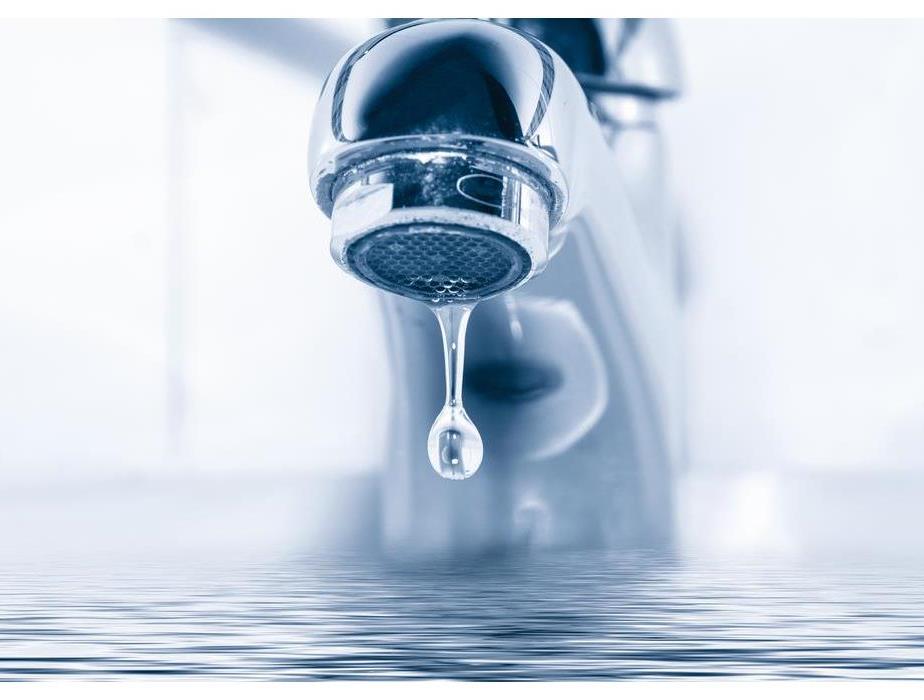 Prevent water damage in your home, give SERVPRO a call at the first sign of a water loss.
Prevent water damage in your home, give SERVPRO a call at the first sign of a water loss.
If you are concerned about water damage in your home, it's important to know what causes it and how to prevent it. Your risk of experiencing a water loss is much higher than most homeowners realize. This is especially true if you live in an area that gets hot or cold weather, or experiences fluctuations in temperature all year long. Some common causes of water damage include broken pipes and toilets, leaking roof tiles or gutters, and faulty appliances such as dishwashers, washing machines, ice makers and more. A proactive approach is the best way to prevent water damage in your home.
Water damage prevention begins with a proactive approach
Water damage is a very common problem in homes. Water damage can be caused by many different things including leaks, water pressure problems, overflowing toilets, and leaking pipes including water heaters.
Assess your homes water risk.
A water risk assessment is a process of identifying the risks in your home that could lead to water damage. This is generally done by professionals, but it can also be done DIY. A professional can help you identify and fix problems before they cause damage, while a DIY kit will give you some basic information on how to assess the risk of water loss in your home.
A professional will conduct an inspection of various areas around your house including roofing materials, gutters and downspouts, and attic vents.
If any issues are found during this inspection, they will be addressed by either replacing or repairing damaged parts so that they don't lead to future problems like mold growth due to moisture buildup inside walls/ceilings etc.
Monitor water usage and report any leaks.
It's important to know how much water you use in a day, week, month and year so that if you do have a leak or other problem with your system it can be addressed quickly and effectively. To test whether there are any issues with the plumbing in your home:
Check for drips from faucets and showers. If you notice any drips at all during these tests then there's probably an issue with either the fixture itself or its connections with piping under floors or behind walls. Give a professional plumber a call at the first sign of water damage.
Check Toilets
Toilets can be a source of major water damage. If you hear a toilet running, check for leaks by looking under the rim of each bowl as well as underneath where you would normally find the water damage. If there is any leakage, fix it immediately before secondary damages occur. Check the guts of the toilet to ensure there are no future leaks.
Plumbing Fixtures
The first thing you should do is check for leaks in your existing fixture. If there aren't any visible signs of water loss and no one has reported noticing any drips coming from their bathroom ceiling or floors then it's likely that your current fixture isn't causing any problems at all.
If you do find evidence of leakage around the base of your valve assembly, then its possible it is time to replace.
There are many things you can do to prevent water loss in your home. Don't let it be a problem in your home. Take action and pay attention when things don't seem right to help prevent water damage that can potentially be costly. Give SERVPRO a call if your in need of water restoration services, we are available 24/7.
Water mitigation vs. Water Damage Restoration
3/7/2023 (Permalink)
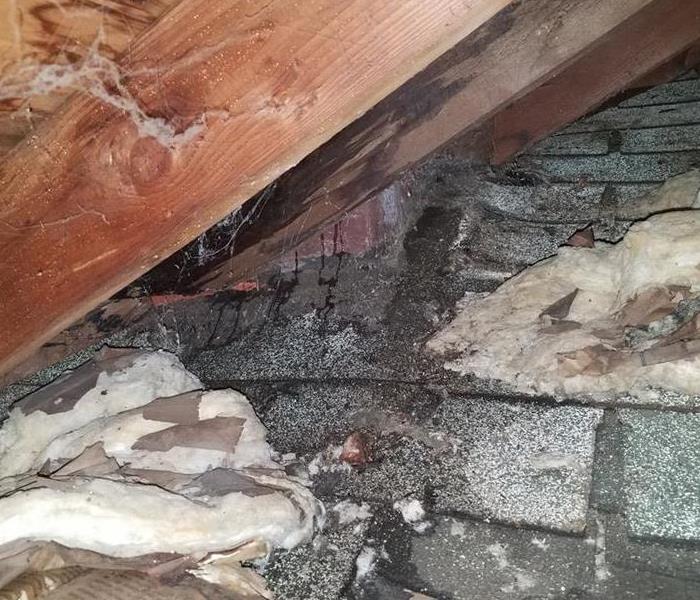 When your in need of water damage restoration, SERVPRO is here to help!
When your in need of water damage restoration, SERVPRO is here to help!
Water damage can cause major issues in your home, but it’s not always easy to determine how you should proceed. Most people assume they need water mitigation services, but what if they are actually experiencing water damage? How do you know which one is right for you? The difference comes down to timing and the extent of the damage.
Experienced Water Damage?
If you have experienced water damage, you may be feeling overwhelmed. It can be difficult to know where to start and what your options are. You might not know who to call or what the process is for getting things back on track after a leaky pipe or burst pipe has wreaked havoc on your home.
In this guide, we'll discuss what causes water damage and how it affects your property so that you can better understand the situation at hand and make more informed decisions about how to move forward. We'll also go over some tips for mitigating water damage in the future so that you don't have to deal with this issue again!
How to proceed?
When dealing with water damage, there are many factors to consider. It is important to know what you are dealing with and how much time you have. This will help determine your options. Additionally, it is important to understand the extent of the damage and whether or not it can be repaired or must be replaced.
It is crucial for homeowners who experience any kind of flooding, whether due to storm surges, high tides after heavy rains fall on coastal areas to contact a restoration company immediately at the first sign of water loss.
Water Mitigation or Water Damage Restoration
If you’re wondering whether you need water mitigation or water damage restoration, the answer is both. The best way to protect your home and belongings is through a proactive approach that includes both water mitigation and water damage restoration.
Water mitigation involves taking steps to prevent damage from happening in the first place. Water mitigation can include sealing off areas where leaks might occur, installing sump pumps, or using flood alarms to sound an alarm when it detects moisture buildup in certain areas of your home. Water damage restoration is a reactive measure which means that it takes place after the initial source of moisture has been removed. In this process, technicians clean and dry out your home so that any remaining moisture does not cause further damage
How do I know which one to Choose?
When it comes to water damage restoration vs. mitigation, there are some key differences. Both processes will help you get your home back to livable condition, but only one of them is a permanent solution. Your choice depends primarily on the type of damage present and how quickly you need to get things back in order.
Water mitigation is a temporary solution used to remove any standing or pooled water from your home so that it doesn't continue causing issues like mold growth or structural damage over time. This process typically uses air movers and dehumidifiers that dry out rooms with fans pushing air through them at high speeds while also extracting moisture using powerful vacuums designed specifically for this purpose
Water Damage Restoration is done AFTER Water Mitigation has removed all possible sources of standing water from your property after flooding events have already occurred.
The most important thing to remember is that this isn’t an either/or decision. You can work with a company that offers both water mitigation and water damage restoration services. It is often best if you do so because they have the expertise and resources needed to help you recover from any type of flood damage—whether it’s minor or major.
I Found a Leak Under My Kitchen Sink
11/5/2022 (Permalink)
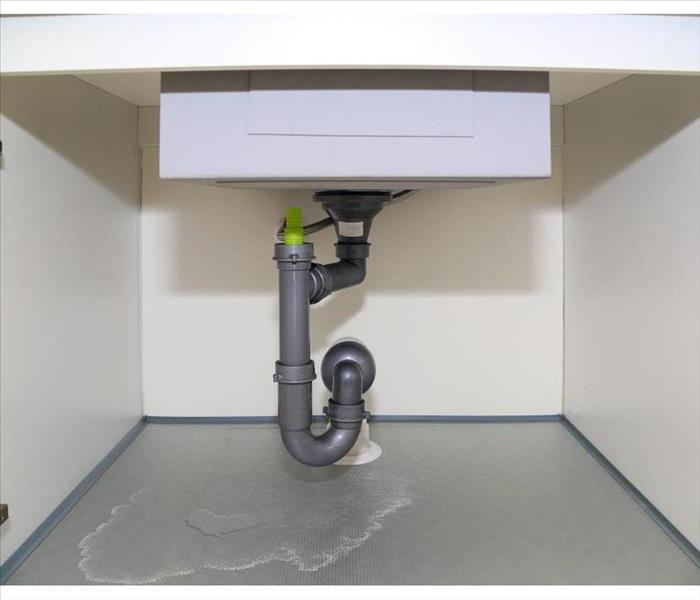 A leak under your kitchen sink can be a big problem.
A leak under your kitchen sink can be a big problem.
A Leak Under the Sink
Consider this scenario: “I found a leak under my kitchen sink. I was doing some organizing when I saw that there was water coming out from underneath the cabinet. After investigating, I realized it wasn't just water; it was oily liquid as well. There were no other signs of damage in the house, so this must be an isolated incident that's not going to spread anywhere else.”
Now that we know what happened and why, let's find out what you should do if you have a leak under your kitchen sink!
A Big Problem
A leak under your kitchen sink can be a big problem. The water will gradually destroy the wood and other materials around it, and if it's not stopped soon enough, it could become an expensive problem.
It's hard to find the leak. There are a lot of places where leaks can occur - around pipes or faucets, in hoses or tubes that connect between different parts of your home. You may have found this out already if you've already searched for the source by turning off all of the water in your house and trying to locate where it's coming from.
Stopping the leak takes time and effort while doing so properly requires skill or knowledge that many homeowners don't have readily available. If something goes wrong while fixing your sink then you could make matters worse rather than better as well as cause even more damage than before!
Tips When You Find a Leak
If you have a leak under your kitchen sink, here's what you should do:
- Shut off your main water supply
- Find the main shutoff valve under your sink and turn it clockwise to close it.
- Call your insurance company if you have homeowners insurance
Call Your Insurance Company
After you've shut off the water, call your insurance company if you have homeowners insurance. This is a great time to check on how much coverage you have and what's covered by it. It's also a good idea to ask about limitations, like whether there are any deductibles or co-pays that need to be paid before the claim can be processed.
Once they've confirmed their coverage and determined how much they'll pay out, they'll let you know what steps need to be taken next, such as getting estimates from contractors so that they can get reimbursed by the insurance company
Call the Professionals
SERVPRO of East Naples is the professional restoration company for you. We have the training and experience to fix your problem. We can handle any size job, from small to large. SERVPRO of East Naples is available 24 hours a day, 7 days a week, including all holidays. We work in both residential and commercial buildings, and work quickly to get you back to normal!
When you find a leak under your kitchen sink, turn off the water, call your insurance company if you have homeowners insurance, and then call SERVPRO of East Naples.
Call the Professionals for Category 3 Water Damage
8/26/2022 (Permalink)
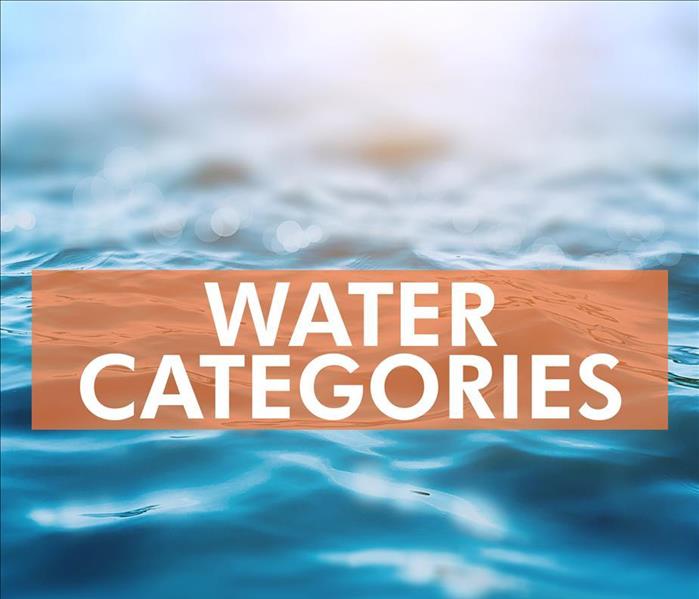 Water damage categories
Water damage categories
Any water damage your Village Walk, FL, property sustains needs to be handled quickly to avoid future issues. When the damage is caused by flood water, it isn’t normal water that is being dealt with. Before diving in to clean up the mess, it’s important to understand the different categories of water loss.
Water Damage Categories
The IICRC classifies water damage in the following three ways:
Category 1: Considered clean water, this is the least severe and may usually be cleaned up without any concerns if there is a minimal amount of damage. This category is often caused by a broken pipe or overflowing sink.
Category 2: Known as grey water, it may have chemicals or bacteria in it. While not necessarily harmful, it still requires an extra level of detail during cleanup. Grey water comes from a urine-only toilet overflow or leaking appliances.
Category 3: If your water problem was caused by flooding, you likely have black water damage. This type has many contaminants from sewage and debris that require added levels of safety. When dealing with this type of water loss, it’s best to call water and mold damaged restoration
Flood Water Cleanup
Unlike clean water, black water must be handled with care. Prior to coming into contact with it, personal protective equipment is recommended. When using a certified company to handle the mess, its trained technicians will be suited up with the right gear and have specialized equipment to contain the area, extract the water and clean affected areas. They will be trained to prevent cross-contamination, as well as find hidden issues, such as mold growth. The team will also properly dispose of waste and unsalvageable items.
While no unwanted water in your property is good, flood water is considered black water and requires extra safety precautions to ensure it is handled right.
Follow These 5 Tips When Cleaning Your Valuables After a Flood
5/27/2022 (Permalink)
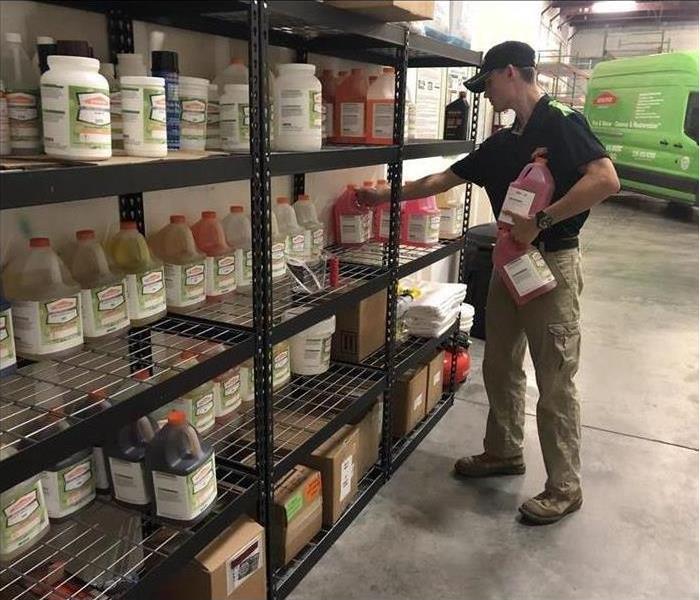 Proper cleaning supplies are crucial for storm preparation.
Proper cleaning supplies are crucial for storm preparation.
Cleaning Contents After a Flood
The damage of water to home furnishings and other valuables in your Village Walk, FL, residence after a flood can be devastating if you don't act immediately to protect them, so follow these tips when cleaning your valuables after a deluge.
1. Handle Photos and Other Valuable Documents With Care
Water in home and family keepsakes leaves them vulnerable to further damage. Photographs and other critical documents are particularly fragile, so handle them with care. Rely on document restoration specialists to repair these valuables. They have specialized equipment that can make your photos and other papers look as good as new.
2. Use Dry Cleaning Services to Preserve Heirloom Clothing
When heirloom clothing such as wedding dresses or antique military uniforms are damaged in a flood, take them to a professional cleaner to restore them.
3. Rinse Wet Items
When water from a broken pipe floods your home, you can gently clean items by rinsing them with a fine spray while they're still wet. Take care not to rub things, or you'll scratch the surface. Protect your skin by wearing latex gloves as your work with items.
4. Let Objects Air Dry Indoors
You don't want water in home furnishings to remain, but airing valuables outside in the sun could cause them to dry too quickly, increasing harm. If possible, let furnishings and other important items dry inside, so they suffer less damage.
5. Beware of Mold
When conditions are damp, mold can start to grow in just a few hours. Open your windows and set up fans so that the area can dry out as quickly as possible.
You don't have to lose your heirlooms and other precious valuables when flooding strikes your home. Following these tips and seeking help from professionals will save those items that you love and want to protect.
Flooded Basement: What is and Isn't Covered by Insurance
5/3/2022 (Permalink)
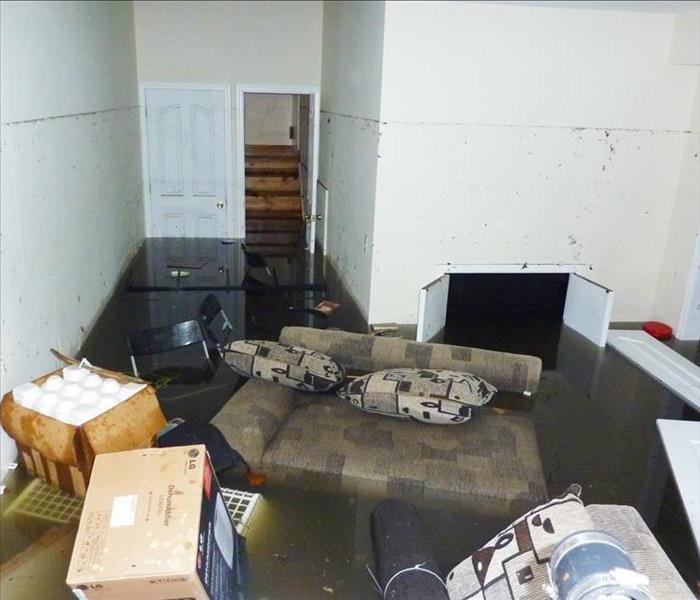 A flooded basement in Heritage Bay, FL.
A flooded basement in Heritage Bay, FL.
Flooded Basement
If you come home to find your Heritage Bay, FL, basement full of water, you know that your first call should be to your insurance agent. However, you might be surprised that not everything is covered by your policy. Here is a breakdown of what kind of damage is and isn't covered by insurance.
Replacing or Repairing the Cause of the Basement Flood
When you identify the source of the water in the basement, you might expect the insurance company to cover the repairs. However, most policies won't cover the cost of repairs for whatever caused the flood. For example, insurance policies won't cover:
- Broken pipes
- Washing machine supply hose leak
- Damaged water heater
- Leaking dishwasher
- Leaking roofing system
You may be able to purchase additional insurance coverage to cover a leaking sewer main and have that repaired at no cost to you.
Damage Caused by Flood Waters
Most standard homeowners policies don't come with flood insurance. So, regardless of whether your basement flood happened because of an intense rainstorm or an overflowing body of water, such as a river or lake, you won't be covered unless you purchase additional coverage.
A simple online search will tell you your risk factor for your home flooding. If you're at a moderate to high risk, you'll want to ensure that you always carry additional flood insurance.
Removing and Repairing Damaged Personal Property
Your insurance policy will replace and repair any personal property damaged in a basement flood. They will also pay to have a water damage repair service come in and make any repairs to the structure of your home so that it is safe to live in. Depending on your coverage, you might have a deductible and coverage limits to consider when organizing the repairs.
A flooded basement can be a major hassle but ensuring you have additional coverage and relying on the pros for clean up will have your space back to normal before you know it.
What To Do if Your Basement Floods
4/5/2022 (Permalink)
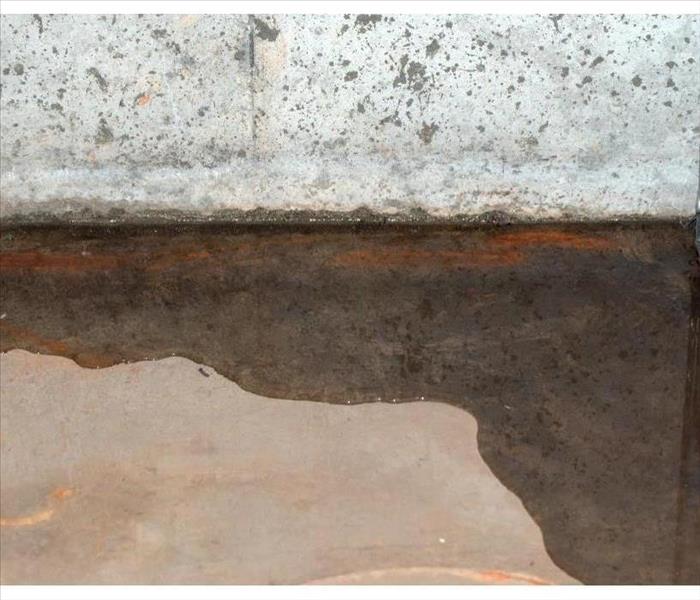 If you find a flooded basement you need to address the source quickly.
If you find a flooded basement you need to address the source quickly.
If Your Basement Floods Here's What You Should Do
Homeowners who experience a basement flood know they need to act quickly to reduce the amount of damage to their homes. After all, this space is probably being used to store more than just off-season decorations. Plus, taking quick action can get your insurance coverage to pay for more of the damage. Fortunately, there are a few steps that are guaranteed to help. Here is what you need to do if water enters your basement.
Find the Source
There are many reasons you would have a basement flood. Your first step is to find the source so you can report to your insurance agent and chosen water restoration company. The most common sources include:
- Natural disasters
- Groundwater seepage
- Sewer backups
- Malfunctioning appliances
- Drain clogs
Turn Off Your Water Supply
You can fix most internal sources by turning off your water supply. The shutoff valve will be located somewhere in or around your house. Usually, it will be in your basement along the wall facing the street. If water is leaking from one of your appliances, you can turn the valve leading to that fixture off. Older homes may not have this feature.
Check Your Sump Pump
In the event of a basement flood, you need to check that your sump pump is working. If you're not sure if it's working, unplug it and let it rest for a few seconds. If it doesn't start working immediately when you turn it back on, buy a new one and replace it.
Check the Floor Drain
If water is coming in through your floor drain, the sewer system in Olde Cypress, FL, could be backed up or your drain is clogged. When your drain is clogged, and water is coming in from another source, you need to unclog it as soon as possible. If the sewer system is backing up, you need to notify the city and call a plumber.
When you go downstairs and find a flooded basement, you need quickly find and address the source. Then, you need to check your drainage measures to make sure they are working.
How To Address Kitchen Sink Leaks
1/24/2022 (Permalink)
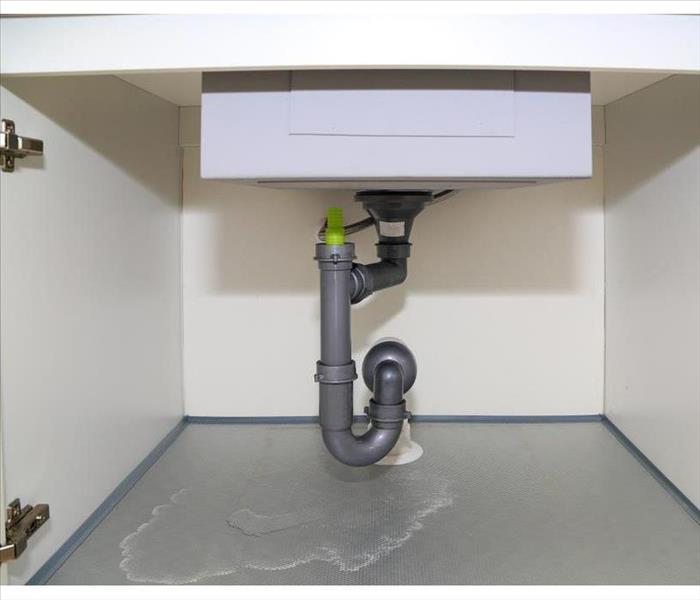 Kitchen sink leaking in Golden Gate, FL.
Kitchen sink leaking in Golden Gate, FL.
What To Do If Your Kitchen Sink Is Leaking
It’s not uncommon for a homeowner in Golden Gate, FL, to contend with flooding issues or other water problems. One of the most likely places to find leaks is under the kitchen sink. These issues can develop over time and slowly occur without your immediate detection. They may also start suddenly due to a burst pipe or plumbing malfunction. If you can effectively respond to these situations, you can avoid disasters and costly cleanup.
Crucial Steps To Take
Once you realize you’ve got water in your home, you need to act appropriately and swiftly so you can minimize damage and remedy the problem. Here are your initial steps when you find a leak under your kitchen sink:
- Find the exact source of the problem
- Shut off the water flow to the sink.
- Call a professional plumber
Find the source
The faster you can determine where the leak originates, the better chance you have of avoiding major flooding. When it comes to leaks in the kitchen sink, there are a few usual suspects. The problem could reside at the valve or supply line, which will be under the sink near or against the wall. If the leak isn’t come from there, it could be a problem with the drain or with the faucet base.
Shut Off the Water
Once you’re confident you know where the leak is coming from, you need to turn off the water so you can put an end to the leaking. It should be simple enough to turn the shutoff knob, but if for some reason it won’t turn easily, you can shut off the main water line to your home.
Call a Pro
Luckily, if severe flooding requires total kitchen repair, you can call a licensed restoration crew to help. Before it gets to this point, you can avoid severe problems and contact a plumber to help you put an end to the leak and get your sink in proper working order once more.
Kitchen sink leaks are annoying, but they’re usually easy to address. Follow these steps and enlist the expertise of plumber, and you shouldn’t have to worry about flooding in your kitchen.






 24/7 Emergency Service
24/7 Emergency Service







